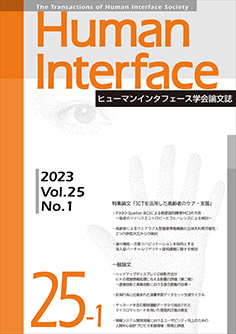Volume 25, Issue 1
Displaying 1-7 of 7 articles from this issue
- |<
- <
- 1
- >
- >|
Papers on Special Issue Subject “Care and support for the elderly using ICT”
-
Article type: Original Paper
2023Volume 25Issue 1 Pages 1-10
Published: February 25, 2023
Released on J-STAGE: February 25, 2023
Download PDF (1359K) -
Article type: Original Paper
2023Volume 25Issue 1 Pages 11-28
Published: February 25, 2023
Released on J-STAGE: February 25, 2023
Download PDF (3325K) -
Article type: Original Paper
2023Volume 25Issue 1 Pages 29-34
Published: February 25, 2023
Released on J-STAGE: February 25, 2023
Download PDF (2276K)
Papers on General Subjects
-
Article type: Original Paper
2023Volume 25Issue 1 Pages 35-46
Published: February 25, 2023
Released on J-STAGE: February 25, 2023
Download PDF (698K) -
Article type: Original Paper
2023Volume 25Issue 1 Pages 47-54
Published: February 25, 2023
Released on J-STAGE: February 25, 2023
Download PDF (14321K) -
Article type: Original Paper
2023Volume 25Issue 1 Pages 55-64
Published: February 25, 2023
Released on J-STAGE: February 25, 2023
Download PDF (1662K) -
Article type: Original Paper
2023Volume 25Issue 1 Pages 65-76
Published: February 25, 2023
Released on J-STAGE: February 25, 2023
Download PDF (2780K)
- |<
- <
- 1
- >
- >|
